Clarice Cliff – bright colours and bold geometric shapes of Art Deco pottery still relevant today
“You see these pieces and you see the amazing colour, vibrancy and life in them, and then you think: how did this woman in the 1920s live in Stoke, in this gritty, wonderful, industrial place, and create these pieces?” says screenwriter Claire Peate, whose new film The Colour Room which is out this month asks the same question.
Born in Tunstall, Stoke on Trent, in 1899, Cliff started working at the potteries as a teenager, like so many Staffordshire women of her era; initially, she was employed as an apprentice enameller, before moving to another factory to become a lithographer.
Mastering one skill meant maximising your earnings - imperative if, like Cliff, you had to earn your keep as part of a big family - yet she continued to swap one apprentice-level job for another.
Her decision to move to the A. J. Wilkinson factory in Burslem, another of the “six towns” that made up the Staffordshire Potteries, proved to be significant both professionally and personally. Here, she would eventually gain a position as an apprentice modeller, a role rarely taken by a woman.
She would also meet the factory’s co-owner Colley Shorter (played in The Colour Room by Matthew Goode), who recognised and supported her flair for design. The pair eventually embarked on a romantic affair (Shorter, 17 years her senior, was married with children) that became, as auctioneer and Cliff expert Will Farmer explains, “the worst kept secret in the world” of the Potteries.
Cliff’s breakthrough came in 1926, against the backdrop of the national coal strike, when “there was basically not enough physical material to make pots,” says Farmer, who acted as a historical advisor on The Colour Room, doing everything from grading replica ceramics on set to providing notes about authentic lighting (pottery workers, he says, “would use either the Stoke Sentinel [newspaper] or tracing paper to diffuse the light” pouring in from windows, “because if the light was too strong the girls couldn’t see what they were doing”). “Clarice knew that there was a huge stock of undecorated wares held in store, and they were sub-standard,” he explains.
To get an idea of the vast scale of Cliff’s success, you just have to look at the feverish press coverage she inspired. “During her key years, which are 1927 to 1936, Clarice featured in over 360 periodicals, magazine and newspaper articles about her and her work,” Farmer says. “You compare that to her closest competitor Susie Cooper, who had less than 30 in the same period.” She was eventually appointed artistic director of both Wilkinson factories; at her peak, they were turning over around 18,000 pieces per week, ready to be shipped across the country and across the Commonwealth, all marked with Cliff’s name.
Cliff had managed to make beautiful, contemporary pieces that women immediately responded to - she just needed to find a way to get the products in front of them. Working closely with Shorter, “a genius at marketing,” she “totally turned the machine on its head,” Farmer says, using colour printed leaflets (rare at the time) to reach her female customers. “She really became an influencer - she went out to women and spoke to them rather than women being told what was beautiful,” McCarthy adds.
Later tactics, commonplace now but pioneering then, included celebrity endorsements and collaborations with other designers. The film has plenty of fun with some of Cliff’s more daring marketing schemes, like Bazooka, a donkey made out of Bizarre ware, and the living window displays in department stores, where shoppers could watch her paintresses at work, dressed in their smocks and berets – something we would still see today in the windows of Harrods, Selfridges or Liberty providing the perfect social media share.
Cliff stepped back from designing in the 40s, when decorating pottery was banned under wartime regulations, and it wasn’t until after her death in 1972 that she was finally recognised and hailed... as a ground breaker in 20th century design. Her work is now highly collectible in the world of ceramics. When Farmer started collecting her work in the 80s, “we didn’t know pattern names… you could find patterns that nobody had ever seen.” The market boomed in the late 90s, coinciding with her centenary, and has, he explains, “got stronger and stronger,” although the market has “done a ‘divide and separate.’ The lesser wares have become very affordable. You could start a collection of Clarice with £10 in your pocket… but you go to the other end of the spectrum now and there are people who regularly part with between £10,000 and £30,000 for a single piece.”
The Colour Room is in cinemas and available on Sky Cinema and NOW from November 12



